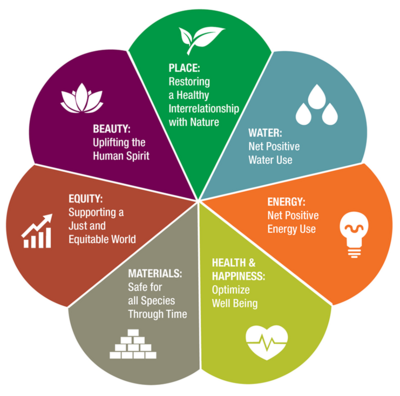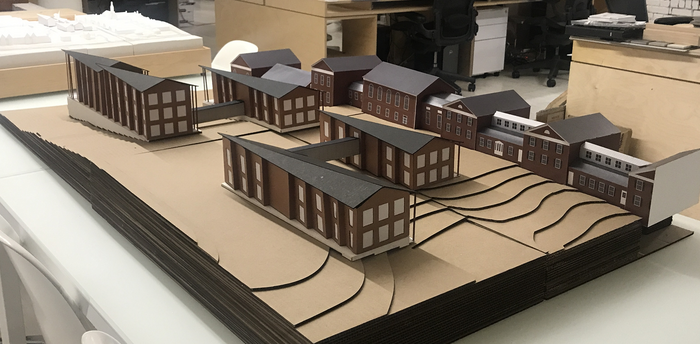Following fundraising success and project approval by the Yale Corporation, Yale Divinity School is moving ahead with design and construction of its history-making Living Village residential complex.
The School will break ground in 2023 on the first phase of the unprecedented off-the-grid student housing.*
 “After years of planning and seeking support, we are thrilled that the Living Village is becoming a reality,” Dean Greg Sterling said. “We are deeply grateful for the donors who have generously supported the project. The project will not only challenge universities and colleges in North America and around the globe to rethink sustainable residences, but it will offer many of our students subsidized housing that will make their education more affordable.”
“After years of planning and seeking support, we are thrilled that the Living Village is becoming a reality,” Dean Greg Sterling said. “We are deeply grateful for the donors who have generously supported the project. The project will not only challenge universities and colleges in North America and around the globe to rethink sustainable residences, but it will offer many of our students subsidized housing that will make their education more affordable.”
Touted as the largest residential living-building project in the education sector, the Divinity School’s Living Village will house approximately 150 students once all phases are complete. Depending on additional funds raised in the next year, the first phase of construction will create housing for 30 to 60 students. Also to be constructed in the initial phase are the power plant and other infrastructure. The remainder of the complex will be built as more funds are raised.
A profound theological statement
The buildings will derive all their energy from the sun and geothermal wells and all their water from local precipitation, while processing waste on site. The complex is being designed to meet the rigorous standards of the Living Building Challenge, whose creator, Jason McLennan, has been a consultant to the project. The firm Bruner/Cott Architects is serving as architects of record, working in collaboration with Höweler + Yoon to design the complex.
 In a time of increasingly severe climate disruption, Sterling says, the Living Village will make a profound theological statement on the imperative to care for the environment and the human flourishing that depends on it.
In a time of increasingly severe climate disruption, Sterling says, the Living Village will make a profound theological statement on the imperative to care for the environment and the human flourishing that depends on it.
Yale President Peter Salovey expressed confidence that the Living Village will be at the forefront of Yale’s ecological efforts and serve as a pathfinder for other universities to follow. “Yale has a deep commitment to environmental sustainability and leading the way to a greener future,” Salovey said. “The Living Village will be a landmark in environmental design on a university campus and set an example for schools around the world.”
“A Sustainable Future for Yale Divinity School”: Read more in Eli Magazine
Yale has incorporated the Divinity School’s Living Village in its Planetary Solutions initiative, which aims to raise awareness of climate and biodiversity work across Yale and unlock novel solutions to the world’s climate threats. The Living Village is a featured component of Yale’s new “For Humanity” fundraising campaign.
“The Living Village is exactly the type of forward-looking project that we need to build a sustainable Yale, to make Yale a model internationally; and to help advance the systems and building techniques that this project will employ,” said John Bollier, Yale’s Vice President for Facilities and Campus Development.
Indy Burke, Dean of Yale’s School of the Environment, said, “The Living Village is a great opportunity to serve students, but best of all, to have Yale serve as an example of an institution leading in sustainable solutions.”
The Living Village, Sterling added, “will help Yale lead by example and position YDS as an unparalleled leader in sustainability in higher education.”
Freeing student from debt, for calling
The Living Village addresses the Divinity School’s highest fundraising priority: to reduce student debt so that graduates can pursue their callings less restrained by financial considerations. Careers of service to churches and communities, Sterling notes, make crucial contributions to individuals and society—but do not typically offer the lucrative salaries needed to pay back heavy student debt loads.
Thanks to donor support, the Divinity School has made dramatic progress in reducing out-of-pocket tuition costs for the more than 90 percent of students who receive financial aid; next year, YDS expects to reach its goal of meeting the full tuition need of students receiving the standard financial aid package.
But living costs remain a burden—which the Living Village will ease by offering below-market rental rates.
Once complete, the complex will replace the outdated student apartments adjacent to the Divinity School quadrangle. Opened in 1957, the apartments have outlived their expected 40-year lifespan and are reaching the point where stopgap maintenance efforts will no longer be effective, Sterling noted.
Formation in community
Like the other professional schools at Yale, YDS trains people to meet the highest standards for their profession and cultivates esprit de corps through social interactions. But YDS goes further, Sterling notes, training students to form and strengthen community in the leadership roles they will assume after graduation, whether at churches, nonprofits, or other types of organizations. One of the central aspects of this training is the community that students experience while studying at the Divinity School.
 The Living Village will be designed to maximize social interactions and community-formation. For example, some of the apartments will be small and without kitchenettes but will have access to common kitchens where social interaction will be frequent and natural. Other common spaces will have sizes and shapes conducive to students coming to know one another; for example, by limiting spaces between buildings to 100 feet, beyond which facial recognition becomes more difficult.
The Living Village will be designed to maximize social interactions and community-formation. For example, some of the apartments will be small and without kitchenettes but will have access to common kitchens where social interaction will be frequent and natural. Other common spaces will have sizes and shapes conducive to students coming to know one another; for example, by limiting spaces between buildings to 100 feet, beyond which facial recognition becomes more difficult.
Fostering belonging
In addition to sustainability and student financial well-being, the Living Village will strengthen the School’s commitment to inclusivity.
The Divinity School’s current campus is modeled after the University of Virginia quadrangle and Jeffersonian in its design and aesthetic, Sterling notes—a nod to a past that, for all its merits, “did not welcome all.” By contrast, and as a complement to the existing quad at YDS, the Living Village will feature a design that looks to the future and creates “a place where all feel and know they belong,” Sterling said. Living Village designers Höweler + Yoon are also the designers of U.Va.’s Memorial to Enslaved Laborers.
The Living Village’s inclusive design is one of numerous actions the Divinity School is taking to foster belonging for all who study, teach, and work at YDS. Among other steps, YDS has dramatically diversified the faculty and curriculum in recent years, while enrolling more students of color, hiring a more diverse staff, and changing its iconography to better reflect the School’s values.
“The values of equity and inclusion must infuse all that we do at YDS, including the way we design our built spaces,” Sterling said. “The Living Village will accomplish this in powerful ways, not only for the benefit of the students who will live there in the near future but for the benefit of future generations and the planet they will inherit.”
“Building Communities of the Future”: Learn more about the Living Village.
*Editor’s note: This article was updated January 4, 2023 to reflect a change in projected project completion timing.